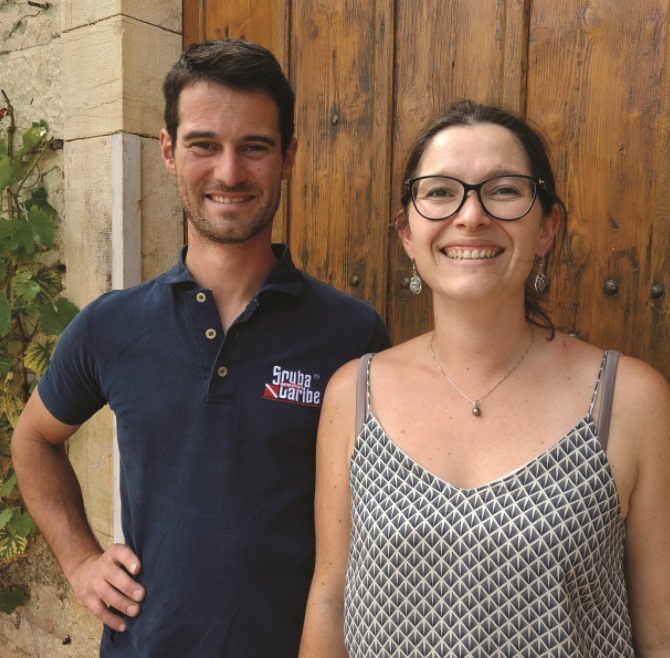
Domaine Capitain-Gagnerot, www.burgundywine.com’s benchmark Burgundy producer, is a historic family estate dating back to 1802, now led by Pierre-François Capitain, who took over winemaking responsibilities in 2008 and represents the ninth generation of the family. Alongside his sister Delphine and their spouses, Pierre-François continues the family legacy, managing about 16 hectares of vineyards located primarily on the famed Corton hillside in Ladoix-Serrigny, near Beaune.
The estate’s long history began with the marriage of Marie Gagnerot to François Capitain in 1864, officially establishing the Domaine Capitain-Gagnerot. Despite challenges such as the phylloxera crisis, the family kept the domain alive and expanding through generations. After World War II, Roger Capitain inherited a modest 3 hectares and managed to grow and modernize the estate. He also became a mentor and friend, teaching cherished lessons in finesse and tradition.
Today, Pierre-François and Delphine lead the domaine with a focus on sustainable farming practices. The vineyards have been Ecocert organic certified since 2021, and biodynamic methods are regularly applied whenever the climate permits. This includes working closely with the vine’s ecosystem, favoring natural treatments, and prioritizing soil health through regular plowing and minimal intervention.
The domain’s terroir is notably diverse, including marl-limestondave suited to white wines and clay-limestone soils producing elegant reds. Vinifications are traditional, with natural fermentations in open tanks without added yeasts, lasting 12 to 15 days with twice-daily punch-downs. The wines are aged exclusively in oak barrels for 12 to 18 months, with new oak never exceeding 10%, ensuring the purity and expression of each vineyard shines through.
Production remains primarily estate-distributed or sold locally, emphasizing quality and connection with customers. The family’s Grand Cru and Premier Cru vineyards span legendary sites including Corton Renardes, Clos Vougeot, and Échezeaux.
Pierre-François remains central to advancing the domain’s reputation for elegance, purity, and rich expression of Burgundy’s best terroirs. The partnership with www.burgundywine.com highlights Capitain-Gagnerot’s blend of centuries-old heritage and modern biodynamic innovation, championing wines that are true reflections of their storied origins.
The decision to sell estate-bottled wine directly to the public requires vigilant attention to detail and an unbending dedication to quality. The most demanding client is the one who ultimately drinks the wine. The Maison Capitain-Gagnerot has a loyal following of individual clients.
They sell 80% of their production themselves in France, much of it ‘out the door’; the remaining 20% is exported, but again, mostly to individuals. They like the personal contact, and often deliver wine themselves to clients as far away as Belgium and Holland. Their US sales amount to several hundred cases a year at this point.
Vine age and yield are important factors to consider at harvest time. The Capitain vineyards have, on average, 40 years of age. The average yield in Grand Cru reds is 40 hl/ha, and in the Corton Charlemagne Grand Cru white, a mere 28 hl/ha.
Many of their vineyards are planted in ‘selection massale’, meaning that rather than using modern clone varieties, these vines are propagated from old, pre-clonal stock, theoretically naturally adjusted to the ‘terroir’. Vineyards are hoed in the winter and plowed in the spring to force the roots deeper. This guarantees maximum exposure to each unique subsoil. It also allows rain water to penetrate the soil, avoiding rapid erosion. Weeding in summer and reasonable disease protection ensure a healthy harvest. Ruthless pruning and ‘green harvest’ keep yields to desired levels.
The domain states on its label that their harvest is done by hand. To them, this is a first indication of quality. Hand-picking is labor intensive, and less demanding growers will take short cuts when possible.
Hand- picking the harvest means that trained pickers can sort good grapes from the damaged ones in the field. Handpicking also avoids unnecessary stems and leaves getting into the crush. The harvest is then completely destemmed, again to avoid green tannins from stems and vegetation.
Vinification in red is ‘traditional’, meaning a cold maceration for 10 to 12 days, leading up to natural (no added yeast) fermentation. The classic ‘floating cap’ is pumped over and punched down twice a day. Fermentation goes to 30C. Reds are raised in 5-10% new oak each year for 12 to 18 months depending on the wine and the year.
Bottling is after a light filtration. Maceration in white is ‘pelliculaire’, meaning that the grapes are macerated whole, allowing the ‘pre-fermentation’ to occur inside the grape skins. This keeps fruit flavors fresh and clean. Alcoholic fermentation takes place at maximum 22C to allow the Chardonnay to preserve its freshness and aromas. All white wines are oak-aged (10% new oak each year) for 9 months. Temperatures are lowered to precipitate tartaric acid. Wines are then fined before bottling.
White
Bourgogne Hautes Cotes de Beaune ‘Les Gueulottes‘
Saint Romain
Ladoix 1er Cru ‘Grechons et Fourtieres’
Ladoix 1er Cru ‘Hautes Mourottes’
Aloxe-Corton 1er Cru ‘La Coutiere‘
Corton-Charlemagne Grand Cru
Red
Bourgogne Pinot et Rose ‘Saignee‘
Cotes de Nuits Villages
Pernand-Vergelesses
Ladoix
Ladoix 1er Cru ‘La Micaude’ Monopole
Ladoix 1er Cru ‘Bois Roussot’
Savigny les Beaune ‘Les Charnieres’
Aloxe-Corton
Aloxe-Corton 1er Cru ‘Les Moutottes’
Vosne Romanee
Corton ‘Les Grandes Lolieres‘ Grand Cru
Corton ‘Les Marechaudes‘ Grand Cru
Corton ‘Les Renardes’ Grand Cru
Echezeaux Grand Cru
Clos Vougeot Grand Cru
